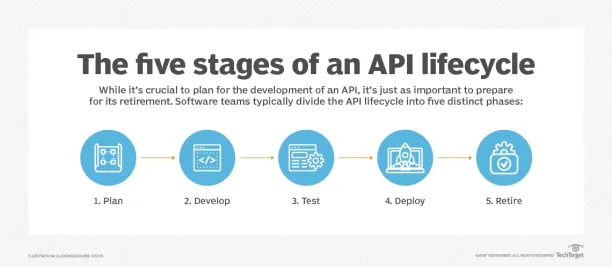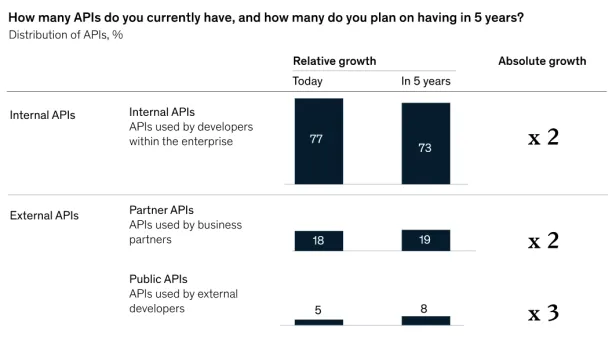In-depth Guide to APIs in 2024: Types, Use Cases, & Life Cycle
97% of enterprise leaders indicate that APIs are mission-critical and it is estimated that 90% of developers use APIs. APIs can have important impacts on a business such as :
- Improving user experience by providing frictionless and fast connection between the database and what the user is looking for.
- Providing more opportunities for innovation. APIs enable developers to get access to many different types of data and integrate them easily with their website or application. This creates a bedrock for making innovative solutions and products.
Thus, APIs are an essential part of digital transformation of companies. That is why in this article we will focus on different aspects of APIs and best practices that executives should be aware of.
What is an API?
API stands for application programming interface. It enables the communication between two or more applications. They are used for:
- Connecting the front end to the important backend functionality and data
- Providing access to data for internal and external users
Thus, APIs are useful for increasing customer satisfaction since they allow movement between applications. It also helps B2B interactions since companies can reach the opportunity of collaboration thanks to APIs.
To learn more about the APIs you can watch the video below.
API life cycle
There is no consensus on the API life cycle and there are different classifications for it. Nevertheless, as Figure 1 illustrates it is possible to explain its life cycle with 5 different stages.
Figure 1: API life cycle

1- Planning
This is the initial stage where you should decide on the overall design of the API and determine:
- Services offered by the API
- API capabilities
- Functional requirement
- Non-functional requirement
Suggestions:
- Your API should solve a problem so make sure it is aligned with your customer/business needs and your overall strategy.
- Check API management solution tools, they can benefit your API development.
2- Development
This is the stage where the API development team starts to code and develop the API. Many different programming languages can be used in API development such as PHP and Python. You should consider the following using KPIs for measuring different aspects of the API such as performance and efficiency.
Suggestions:
- Implement an agile software development approach.
- Development is a team-based task so make sure clear communication channels exist between developers.
- Encourage cross-team collaboration.
3- Testing
Testing will find bugs and glitches in the API before the deployment of the API. Testing can save a considerable amount of money as the cost of bugs found in the testing stage is cheaper than in later stages.
For more on API testing, read API Testing: 3 Benefits & 8 Different Types.
Suggestions:
- Use continuous testing starting in the development stage.
- Automate your testing as much as possible. Automated testing reduces time, cost and increases the coverage of testing.
Sponsored
Testifi is a test automation solution provider that enables AI-based API testing automation through their PULSE tool. It reduces costs & cycle time by 50% and allows performance monitoring.
4- Deployment
After the testing phase is done, the API can be deployed. The deployment phase can be thought of as the 2nd stage of testing because in this stage you will receive customer feedback.
Suggestions:
- Have an adequate customer feedback collection system. Utilize customer surveys, focus groups, and a/b testing.
- Have a version call option so customers can use the older version in case the new version is not stable and has problems.
- Communicate with clients about actions to take to experience less disruption in case of a new version release.
5- Retirement phase
The previous stages can continue by making new versions and updates for an API. However, eventually, there will be a time that an API must be retired. Plan the migration path diligently and have an end-of-life plan for the API to reduce the negative impact of API on daily operations.
Suggestion: Communicate the retirement plan to customers clearly and offer support for the transition.
Different API protocols
REST
REST or RESTful API stands for representational state transfer. To be conceived as a RESTful API, the API must have the following criteria :
- Client-server separation: The client must request and the server should answer, it can not work the other way around.
- Stateless: No client request data is stored in the server.
- Cacheable data: The server response should clearly indicate if the client can cache the response.
- Uniform interface: Requests and responses must use HTTP as their communication protocol.
- Layered system: Requests and responses should be identical in their format.
SOAP
SOAP stands for simple object access protocol. It is a protocol that uses XML to encode information. It can operate across a range of different communication protocols in contrast to RESTful APIs.
SOAP APIs can be a better choice for making internal APIs because SOAP APIs have better security measures due to their decentralized massaging transmission protocol.
To understand the difference between REST and SOAP APIs, watch the following :
4 API Types
There is no superior type of API. Each type has its benefits, which is why you should ensure that the type of the API matches your objective.
1- Open API
They are also referred to as public APIs. They are available to the public. They might require an API key or registration or be completely open.
Advantage: Open APIs allow data sharing with ease and can be monetized by the API owner usually through a tiered system based on the number of API calls.
2- Internal API
They are the opposite of open APIs. They are only available for internal use in an enterprise and are used for internal data transfer.
Advantage: They benefit a business by increasing efficiency through streamlining data access.
3-Partner API
Only authorized external parties can use the API. Developers provide authorization or licenses to the clients to use the API.
Advantage: Partner API benefits the API owner by enhancing security and control on how and why the data is being used.
4- Composite API
They Combine different APIs or different end points of an API in one place which allows different information to be collected with one API call.
Advantage: Composite APIs can reduce the server load time and the overall system complexity.
Use cases of API
Finance
Only 30% of financial institutions use APIs. However, it is estimated that API usage in banking to grow significantly in the next 5 years (see Figure 2)
Figure 2: API growth in the banking industry

Source: McKinsey
API in financial services can be used for:
- Improving banking processes such as account verification and obtaining customer credit score
- Letting insurers access customer data via IoT integrations like wearables which improves insurance underwriting and risk scoring.
- Accessing account history in a standardized format
- Accessing financial instruments prices for making different financial models.
Examples of finance-related APIs :
- CryptoSlam NFT API for accessing NFT prices.
- Morning Star market data API for accessing financial market data.
To understand more about API use cases in finance, read Open Banking APIs: Benefits, Opportunities & Applications.
Supply chain
API in the supply chain can be used for different purposes such as :
- Getting accurate carrier sport rate information
- Automated billing
- End-to-end visibility for shipment tracking
- Duty and tax calculation for international shipping
Examples of supply chain API by logistic or 3PL companies are :
To have a better understanding of API in supply chain, read Supply Chain APIs vs EDIs: Benefits & Downsides with Example.
Healthcare
Use cases of APIs in healthcare are:
- Providing healthcare-related apps with consistent access to health information
- Provide healthcare providers with an innovative way to access patient data that is stored in electronic health records (EHR).
- Consolidating data with different formats into a single document
Many healthcare-related APIs have been developed for example:
- EPIC on FHIR API for accessing health information
- Athena API for accessing the WHO data portal
To understand more about healthcare APIs, read Healthcare APIs: 7 Use cases, 7 Case studies & 3 Challenges.
Retail
API can benefit the retail industry in various ways and in different parts of its operation, for example:
- Simplifying payment methods by integrating different payment methods such as Google pay.
- Onboarding of new clients takes time as client access to different catalogs should be done manually. APIs can be used to shorten the onboarding period.
- Clear and faster communication between parties can be achieved by using APIs. APIs can retrieve different information in a short period for actions such as order status.
Examples of retail APIs are:
- Retail API by google. This API allows the creation of personalized recommendation systems.
- Amazon data service by Axesso. It is possible to retrieve information such as manufacturer, price, size selection etc from Amazon using this API.
To have a better understanding of API in the retail sector, read Top 5 Use Case of API in Retail with Examples.
Further reading
For more on AI and automation
If you are ready to deploy automated testing, feel free to check out our data-driven, transparent list of top vendors that can enable testing automation.
If you are interested in investing in AI solutions, check out our data-driven list of Data Science / ML / AI platforms.
And if you need help choosing the best tool for your business, reach out to us for guidance:

Cem has been the principal analyst at AIMultiple since 2017. AIMultiple informs hundreds of thousands of businesses (as per similarWeb) including 60% of Fortune 500 every month.
Cem's work has been cited by leading global publications including Business Insider, Forbes, Washington Post, global firms like Deloitte, HPE, NGOs like World Economic Forum and supranational organizations like European Commission. You can see more reputable companies and media that referenced AIMultiple.
Throughout his career, Cem served as a tech consultant, tech buyer and tech entrepreneur. He advised businesses on their enterprise software, automation, cloud, AI / ML and other technology related decisions at McKinsey & Company and Altman Solon for more than a decade. He also published a McKinsey report on digitalization.
He led technology strategy and procurement of a telco while reporting to the CEO. He has also led commercial growth of deep tech company Hypatos that reached a 7 digit annual recurring revenue and a 9 digit valuation from 0 within 2 years. Cem's work in Hypatos was covered by leading technology publications like TechCrunch and Business Insider.
Cem regularly speaks at international technology conferences. He graduated from Bogazici University as a computer engineer and holds an MBA from Columbia Business School.
To stay up-to-date on B2B tech & accelerate your enterprise:
Follow on

Comments
Your email address will not be published. All fields are required.